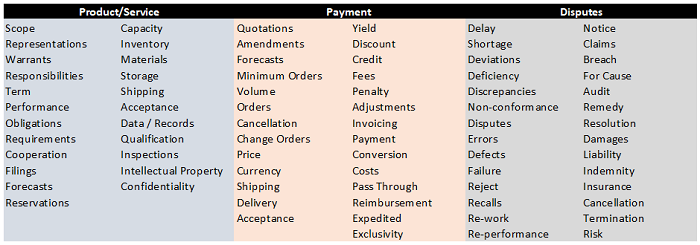CDMO Selection: 3 Questions To Save Time And Reduce Stress When Reviewing An MSA
By Ray Sison, xCell Strategic Consulting, LLC

Whether because of unfamiliarity or lack of resources, master service or supply agreement (MSA) execution can be time consuming and difficult. At any given pharma company in the development or clinical stage, the leadership team and investors prioritize patients, therapies, and trial results. Equally important to success is a drug product supply chain for manufacturing, packaging, and distribution. Selecting CDMOs to support clinical trials that can also drive product launch is a challenging but critical task for many companies with novel compounds, e.g., highly potent drugs such as cytotoxics, biologics (including gene/cell therapies), and aseptically manufactured products. But unlike specialty and large pharma, startups typically do not have sophisticated procurement teams responsible for CDMO partnering.
 Having negotiated for both buyers and sellers, I've developed shortcuts and best practices to help save time whenever a 55-page document hits my inbox and only one month is in the timeline for contract negotiation. First, understand that an MSA is not a novel, read from front to back. It is a functional legal document that provides operational, financial, and legal guidance that will be referenced as needed throughout the term of the agreement. My perspective represents the technical and operational functions leading the CDMO selection. Rely on your Quality, Regulatory, Legal, and other stakeholders to contribute in their respective areas of expertise.
Having negotiated for both buyers and sellers, I've developed shortcuts and best practices to help save time whenever a 55-page document hits my inbox and only one month is in the timeline for contract negotiation. First, understand that an MSA is not a novel, read from front to back. It is a functional legal document that provides operational, financial, and legal guidance that will be referenced as needed throughout the term of the agreement. My perspective represents the technical and operational functions leading the CDMO selection. Rely on your Quality, Regulatory, Legal, and other stakeholders to contribute in their respective areas of expertise.
Negotiation Starts Before You Receive The MSA
Negotiation starts with the request for proposal. In a competitive bidding process, stipulate up front that in order to be a finalist (primary or backup), a bidder must provide an MSA template in Microsoft Word outline format with all internal references hyperlinked. If their template isn't already formatted this way, they will thank you for it later. This will allow anyone to create a table of contents (ToC) quickly if it is not included and to move through the document with ease. It also eliminates reformatting when sections are added/deleted and it updates all references automatically, reducing turnaround time on both ends.
Use the ToC or top-level outline view from the primary and backup bidders to get a general sense of structure and to determine if any critical sections are missing from either template. This benchmarking is the first level of comparison and can be scored as part of the overall evaluation. If timing is the top priority, the primary bidder may be determined based on the quality and anticipated negotiation effort of the MSA.
Focus On Each Function Separately
After the preliminary comparison, read each MSA three times. That's right, it sounds counterintuitive, but, as stated above, the MSA serves three broad functions and should be read with a focus on each in turn. Keeping each function separate allows you to identify and group sections and then to agree/disagree/comment in a logical flow.
Here are three questions you should continually ask yourself during review:
- Operational: What am I buying?
- Financial: How am I paying?
- Legal: What happens if (when) things go wrong?
In your first pass, take on an operational perspective and read only sections that make mention of products and services. As the owner of the relationship, drug product development (technical) or supply chain (operations) teams must live with the agreement after it is signed. From a supply chain viewpoint, look at anything related to product or information flow. Be sure that your expectations are clearly reflected in the document and, if not, add comments. Remember that what is being bought could be a good or service, but it might also be data, reports, documents, or other output that will support a filing. Identify all references to goods or services and map them to your organization. Reflect on any previous technical and operational experience you have had with outsourcing and how you interacted under normal circumstances to obtain the deliverables outlined in the quotation.
In your second pass, look only at sections or subsections that discuss the financial aspects of the relationship. In development projects, there are up-front payments, monthly and milestone payments, and then there are the triggers for each. For commercial supply, there are forecasts, orders, release, shipping, etc. Each may trigger some level of payment. Be clear on the definitions for what constitutes the trigger for payment and comment accordingly. Other fees, pass-throughs, and penalties will be mentioned. Weigh in on what you are willing to accept, reject, or modify. From a supply chain viewpoint, look at anything related to money or information flow.
For the third pass, channel everything and anything you can recall that has ever gone wrong with a project and what happened in the aftermath. Read the sections that address abnormal circumstances and calibrate the fairness of the CDMO’s position. Would the document provide useful guidance for your previous experiences? Are penalties/remedies reciprocal where appropriate? Your legal and regulatory colleagues should provide heavy input in this aspect. Agree on how to prioritize negotiation points. Be prepared to cite specific examples of real-world experiences to drive your points when negotiating with a CDMO. Few attorneys have ever been in a lab, warehouse, or manufacturing floor and thus they will have little context for the contract language. This is where operational input will be most valuable during negotiation.
Table 1: Search Keywords for MSA Functions

Best Practices, Preparation Reduce Cycle Time
After completing the three passes, here are a few best practices to prepare for MSA negotiation and reduce review cycle time:
- Check any references to the quality agreement and ensure that it is properly aligned.
- Skim the backup MSA for context and further benchmarking.
- Keep a running tab on key negotiation points under each function to include in the body of an email when forwarding the document for internal review. This allows the internal stakeholders to focus their review and helps to set the agenda for negotiation.
The technical or operations lead is usually the person driving the CDMO selection process and receives the MSA directly from the CDMO. As the first reviewer, the ability to effectively process the document and then pass along meaningful comments and negotiation points will set the stage for developing an internal strategy. While it is not unusual for Legal to take the lead in contract negotiations, as owner of the relationship the project lead should be at the table providing clear guidance and subject matter expertise. The concepts in this article can help you better prepare for the negotiation and ultimately tip the balance. If negotiations hit an impasse, be prepared to move to the backup bidder. Obviously, nobody wins every battle, so bear in mind that the goal is to protect your company's interests while not hindering progress toward company objectives. Strike a balance, close the deal, and get ready for project kickoff.
About The Author:
 Ray Sison is VP of Pharmaceutical Outsourcing and Tech Transfer at xCell Strategic Consulting. He began consulting in 2011 after recognizing a need for expertise in pharmaceutical outsourcing among the discovery- and clinical-stage pharma companies he served as a business development representative for Patheon and MDS Pharma Services. Based on his experience, Sison provides insight to the CMO’s business and operations, helping his clients negotiate and achieve better outcomes. Additionally, he has developed sound processes and templates to streamline CMO procurement to save time and cost. In this series of articles, as well as online webinars, he continues to share best practices and case studies, helping improve the outsourced business model. You can reach him at rsison@xcellstrategicconsulting.com or connect with him on LinkedIn.
Ray Sison is VP of Pharmaceutical Outsourcing and Tech Transfer at xCell Strategic Consulting. He began consulting in 2011 after recognizing a need for expertise in pharmaceutical outsourcing among the discovery- and clinical-stage pharma companies he served as a business development representative for Patheon and MDS Pharma Services. Based on his experience, Sison provides insight to the CMO’s business and operations, helping his clients negotiate and achieve better outcomes. Additionally, he has developed sound processes and templates to streamline CMO procurement to save time and cost. In this series of articles, as well as online webinars, he continues to share best practices and case studies, helping improve the outsourced business model. You can reach him at rsison@xcellstrategicconsulting.com or connect with him on LinkedIn.
